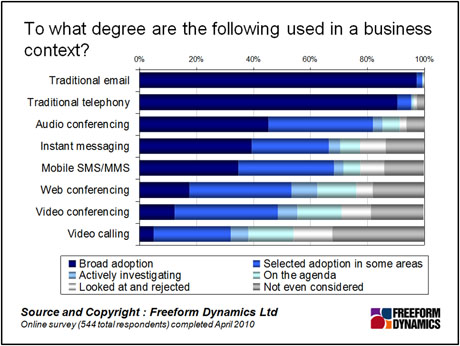It is probably fair to say that the likelihood of videoconferencing becoming mainstream in the next year or so is slim. Of course, many vendors will no doubt vehemently disagree with this, and claim that the videoconference revolution is only just around the corner. For some, maybe, but not for all. In spite of the often touted benefits, such as the ability to involve remote teams in ’face-to-face’ meetings, reduced travel budgets and time lost due to travelling, there are a number of negatives that videoconferencing struggles to overcome. To begin with, professional business-grade video conferencing is generally acknowledged as being expensive, and difficult to set up and maintain, with specialised equipment required at both ends of a connection, often in a pre-designated, and often purpose-built room. In addition, latencies on video calls can make them, at times, painful to participate in. And perhaps most importantly, a lot of people just aren’t comfortable with their picture on the screen, and are happier sticking with the tried and tested audio conference, perhaps calling on web-conferencing when some visual interface, such as a set of slides, is required.
But while video conferencing is unlikely to replace the humble phone call any time soon, it shouldn’t be dismissed out of hand. It is certainly already well past the starting post, no doubt egged on somewhat by the continual stream of travel woes affecting businesses such as rail and air strikes, the recent disruption caused by the ash cloud, and swine flu , along with shrinking travel budgets and changing work practices. Recent research carried about by Freeform Dynamics with companies into their use of advanced business communications revealed that while video conferencing is less widely used than most communications tools, it is at least on the agenda in some shape or form for many, although broad adoption is fairly limited.

But just implementing video conferencing doesn’t automatically guarantee that it will deliver benefits to the business. And in fact, if the expectation is that it will be used just because it is there, then it most probably won’t. In fact, in this scenario, it is more likely to end up with the cameras pushed towards the wall while people just use the system for voice. The ’trick’ in getting it to really work in the organisation is to ensure it has a good home in the overall communications strategy. This demands a real ’top-down approach’ to make it happen, with senior and middle management as genuine flag-wavers of the solution. This means getting them to actually use it, not just talk about it, e.g. by starting to organise meetings themselves on a regular basis, and getting inventive with strategies around this. Some companies, for example, have had ’competitions’ to see who can cut the most travel budget by using video conferencing, with prizes for the winners. Of course, ensuring that everyone uses meeting best-practices, such as clear agenda etc., applies here just as it would in any other type of meeting. Like most technologies, once videoconferencing starts being used successfully, and talked about, everyone else will demand to use it.
It is probably also worth remembering the old maxim of horses for courses, and identifying precisely which courses work best for video conferencing. For example, in some companies, larger group meetings aimed at disseminating information, where information flows from one site to many others but not much interaction is expected from the satellite sites, are probably well suited to videoconference sessions, whereas smaller, interactive discussions might be better handled by a web or audio conference. In other companies, the reverse may be true. The point is that video conferencing is not a solution that solves all meeting needs, and is very much about delivering specific values in well-defined scenarios. It works much better when it coexists with others tools, such as web and audio conferencing. Over time, individual company experience will determine the best tool for any given communications objective.
On a final note, when video conferencing is considered as a component or ’option’ within a broader communications solution such as Unified Communications (UC), interest increases significantly. With this in mind, UC just might be the conduit that pushes video conferencing into the spotlight, even if it is one shared with a whole raft of other communications tools.
Content Contributors: Josie Sephton
Through our research and insights, we help bridge the gap between technology buyers and sellers.



Have You Read This?
Generative AI Checkpoint
From Barcode Scanning to Smart Data Capture
Beyond the Barcode: Smart Data Capture
The Evolving Role of Converged Infrastructure in Modern IT
Evaluating the Potential of Hyper-Converged Storage
Kubernetes as an enterprise multi-cloud enabler
A CX perspective on the Contact Centre
Automation of SAP Master Data Management